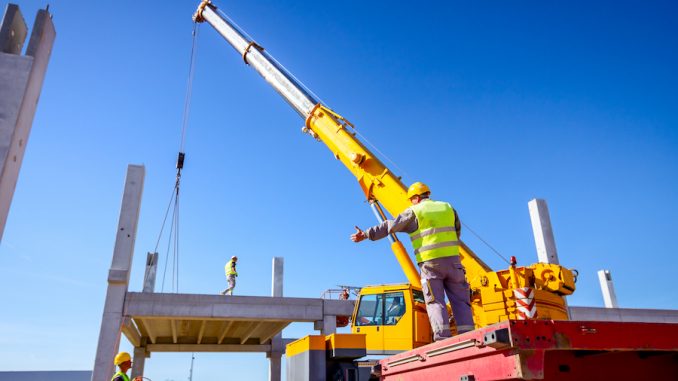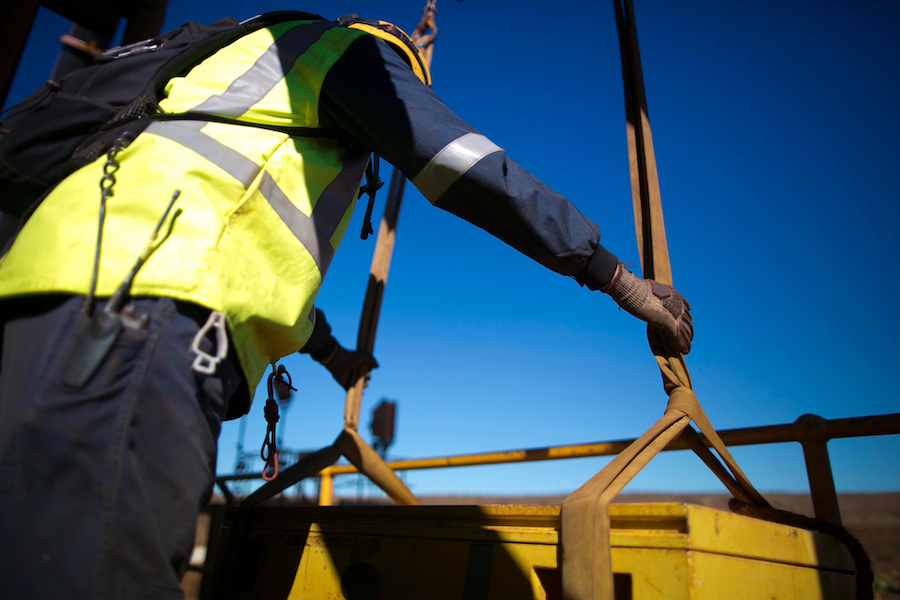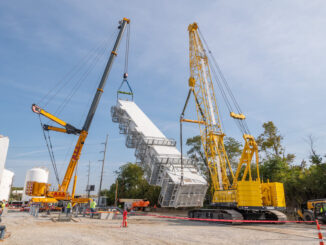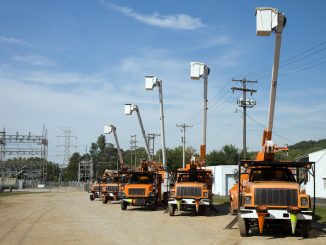
View the complete article here.
Rigging is an integral part of various industries—demanding precision, safety, and expertise. This guide covers the fundamental concepts and essential terms of rigging, providing contractors with the knowledge to execute their projects safely and efficiently. From understanding the basics of load dynamics and the meticulous role of a rigger, to grasping the significance of equipment such as slings and shackles, this guide is an essential read for those in the field.
Basic Rigging Concepts
Rigging refers to the process of lifting and moving heavy objects with the aid of ropes, cables, chains, hoisting equipment, and other mechanical devices. The scope of rigging extends beyond merely lifting loads—it encompasses the selection and inspection of rigging gear, the planning and execution of lifts, and the management of the safe movement of loads to different locations within a job site. It involves a deep understanding of physics, material strengths, load dynamics, and environmental factors that can affect the safe handling of heavy materials.
The rigger is a pivotal figure in construction projects, responsible for ensuring the safety and efficiency of the lifting operations. Their roles often include:
- Planning and preparation: Assessing the weight and dimensions of loads, selecting the appropriate rigging gear, and determining the best method of transport.
- Inspection: Performing pre-use checks of all equipment and gear to ensure they are in good condition and compliant with safety regulations.
- Load attachment: Safely attaching loads to lifting devices using slings, chains, shackles, and hooks.
- Signal communication: Using hand signals or radios to guide crane operators during the lifting and moving processes.
- Safety management: Monitoring the rigging process to anticipate and mitigate risks, ensuring the safety of all personnel involved.
- Load control: Managing the movement of the load—including lifting, swinging, and placing it accurately and safely.
- Maintenance: Conducting regular maintenance and post-operation inspections to preserve the integrity of rigging equipment.
- Compliance: Ensuring all rigging activities adhere to local, national, and industry-specific regulations and standards.
Any errors in rigging can lead to serious accidents—including damage to property, injury, or even fatalities. Therefore—riggers must be highly skilled, well-trained, and certified where required.
Essential Rigging Terms
For those working in any rigging environment, the following terms should be understood…
Load: The term ‘load’ in rigging refers to the object or objects being moved or lifted. Loads can be categorized as:
- Static loads: These are stationary and do not change position or shape during lifting. They generally exert a consistent force on the lifting gear.
- Dynamic loads: These can move or change position during lifting and may exert varying forces on the rigging equipment due to motion, wind, or other external factors.
Lift point: The lift point is the specific location on the load where the rigging equipment attaches. It’s critical for balance and control of the load during lifting operations. The lift point must be structurally sound to handle the forces exerted during the lift.
Sling: Slings are the flexible straps used to attach the load to a lifting device. They come in various materials:
- Wire rope slings: Durable and suitable for heavy loads and harsh conditions.
- Chain slings: Extremely strong and ideal for lifts that require high temperature or abrasion resistance.
- Synthetic slings: Lightweight and versatile, they protect delicate loads from damage. Selection criteria include load weight, sensitivity, temperature, and environmental conditions.
Shackle: Shackles are U-shaped pieces of hardware used to connect the lifting device to the rigging. They come in different types like bow shackles and D-shackles, each serving specific applications based on load type and environmental conditions.
Working load limit (WLL): WLL is the maximum load that rigging equipment is certified to safely handle under normal conditions. It’s a critical safety measure, ensuring that rigging equipment is not overloaded.
Breaking strength: This is the maximum load that can be applied to a rigging component before it fails or breaks. Breaking strength is usually a multiple of the WLL and provides a safety buffer.
Choker, basket, and vertical hitch: These are common sling configurations:
- Choker hitch: Wraps around the load—cinching tight when lifted, for a secure grip.
- Basket hitch: Cradles the load and is used when the load needs to be balanced or protected from damage.
- Vertical hitch: A single sling supports the load vertically, suitable for loads with dedicated lifting points.
- Bridle hitch: A bridle hitch involves multiple sling legs attached to separate lift points on the load, offering improved load control and distribution.
D/d ratio: This ratio compares the diameter of the rope or sling (d) to the diameter of the curve over which it is bent (D). A higher D/d ratio means less stress on the sling and longer sling life.
Snatch block: A snatch block is a type of pulley used to redirect the lifting path of a rope or wire. It can also be used to increase the mechanical advantage in a lifting system.
Rigging plate: A rigging plate is a device that allows for the organized attachment of multiple slings, ropes, or hardware to a single point—enhancing the stability and balance of complex rigging setups.
Load angle factor: This refers to the reduction in a sling’s WLL based on the angle at which it is used. As the angle between the sling and the load becomes more acute, the effective WLL of the sling decreases—necessitating adjustments for safe operation.
 Rigging Equipment
Rigging Equipment
The following are the most common types of equipment associated with rigging operations…
Cranes: Cranes are pivotal in lifting and moving materials in construction. Their selection is based on load requirements and site conditions. The three most common types include:
- Mobile cranes: Versatile and moveable, used where temporary lifting is needed.
- Tower cranes: Tall, with a high capacity, ideal for skyscraper construction.
- Overhead cranes: Installed on beams in industrial environments for moving heavy items along a fixed path.
Hoists: Hoists are devices used for lifting or lowering loads using a drum or lift-wheel. There are three types of hoists:
- Manual hoists: Operated by hand, suitable for smaller loads and places without power.
- Electric hoists: Powered by electricity, efficient for repetitive lifting tasks.
- Pneumatic hoists: Use compressed air, ideal for flammable or explosive environments due to their spark-resistant properties.
Winches: Winches are used to pull or lift loads and include:
- Hand-operated winches: Require manual effort, ideal for smaller tasks or where power is not available.
- Powered winches: Use an electric, hydraulic, or pneumatic motor—allowing for the handling of larger loads with less manual labor.
Blocks and pulleys: These are wheel-based systems used to change the direction of a force and to gain mechanical advantage.
Come-alongs: Come-alongs are hand-operated ratchet devices used for pulling and tensioning. They are useful in positioning heavy equipment or aligning structural components. They are not typically designed for lifting, but rather for pulling horizontally.
Beam clamps and trolleys: Beam clamps and trolleys provide a temporary point from which to hang hoists and other lifting devices.
- Beam clamps: Attach directly to a beam and are used to hang hoists or as a lifting point.
- Trolleys: Move along the beam, allowing for horizontal movement of the load.
Spreader bars and lifting beams: Spreader bars and lifting beams distribute the weight of a load across more than one point. Essential for preventing damage to the load and ensuring safety, they increase the stability of a lift and help maintain the integrity of delicate or flexible loads.
Turnbuckles: Turnbuckles are devices for adjusting the tension or length of ropes, cables, and other tensioning systems: They are used to fine-tune the rigging setup for precise alignment and load distribution.
Wire rope clips: Wire rope clips are fittings used to make eye-loop connections or to join two ends of wire rope. They are vital for creating attachment points on a cable without the need for specialized tools or swaging.
Rigging Techniques
Technique is crucial while working with rigging operations…
Splicing: Splicing is a technique used to join two pieces of rope or to create an eye (a loop on the end of a rope) without significantly compromising its strength. The three types of splicing techniques includes:
- Back splice: Prevents the end of a rope from fraying.
- Eye splice: Creates a permanent loop at the end of a rope, useful for attaching hooks or other hardware.
- Short splice: Joins two ropes together end-to-end for a strong (though somewhat bulky) connection.
Knotting: Knotting is fundamental in rigging to secure ropes and loads. The three most common knots include:
- Bowline: Creates a fixed loop at the end of a rope, known for its strength and ease of untying.
- Clove Hitch: Used to attach a rope to a post or beam, valuable for its quick application.
- Figure-Eight: A stopper knot that prevents the rope from running out of retaining devices, known for its high strength and stability.
Signal methods: Effective communication is critical in rigging operations, including:
- Hand signals: Non-verbal, visual cues universally understood by riggers and crane operators to direct actions such as lifting, lowering, and stopping.
- Verbal communication signals: When visibility is low or distances are too great, verbal commands via radio or other audio devices are used.
Load balancing: Load balancing ensures stability and safety of the lift. Techniques involve selecting the right type of sling and rigging arrangement to distribute the load’s weight evenly across all attachment points.
Inspection and maintenance: Routine checks are vital for rigging safety. Inspecting equipment before and after use for signs of wear, damage, or fatigue. Following a maintenance schedule to ensure all equipment is in good working order and compliant with safety standards.
Sling angles: The angle between the sling and the load is critical for load control. Calculating the correct angle to ensure that the sling can safely support the load without overstressing any part. Adjusting angles to spread the force across the slings and prevent damage to the load or the slings themselves.
Complex lifts: These involve the coordination of multiple cranes. Planning for multi-crane lifts requires understanding the capacities of each crane and careful coordination to ensure the safety and balance of the load.
Rigging plans: Developing comprehensive plans for complicated lifting scenarios is essential for safety and efficiency. It should involve detailed assessment of the lift site, the load, the required equipment, and the personnel involved. Plans should include contingency protocols for potential problems or emergencies during the lift.
Final Thoughts
A thorough understanding of rigging is essential for the safety and success of construction projects that utilize any sort of lifting operations. By mastering the terms and techniques discussed, contractors can ensure lifts are performed efficiently and safely—minimizing risks and maximizing productivity.
View the complete article here.
What are the key responsibilities of a rigger in construction projects?
The rigger is responsible for planning and preparation, equipment inspection, load attachment, signal communication, safety management, load control, maintenance, and ensuring compliance with regulations.
What are the common types of slings used in rigging, and how do they differ?
Slings include wire rope, chain, and synthetic types, each suited for specific conditions based on factors such as load weight, sensitivity, temperature, and environmental conditions.












































